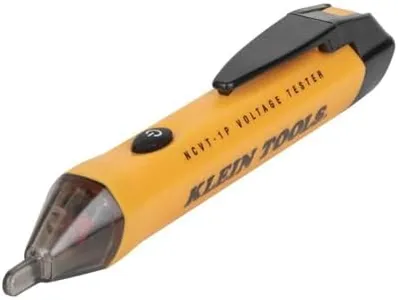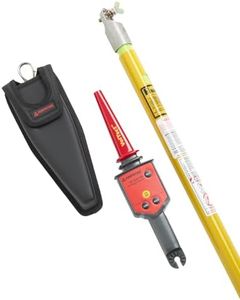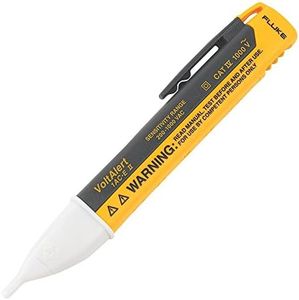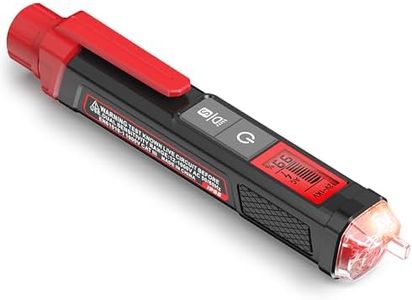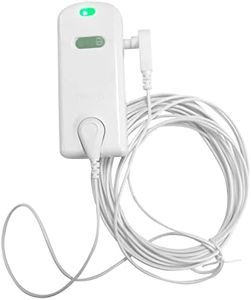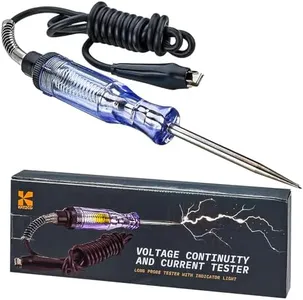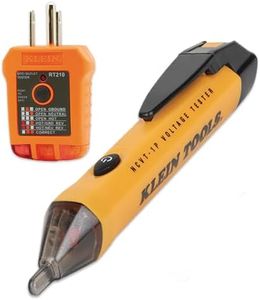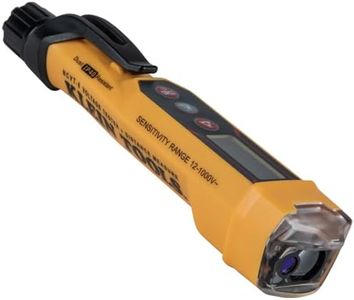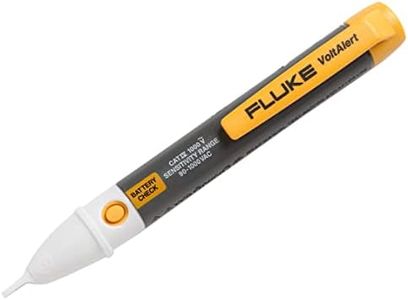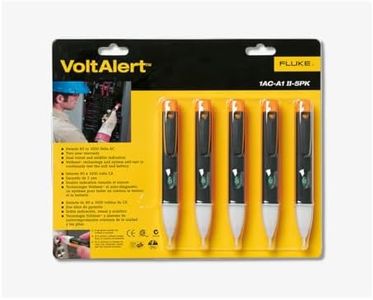10 Best Non Contact Voltage Tester 2025 in the United States
Our technology thoroughly searches through the online shopping world, reviewing hundreds of sites. We then process and analyze this information, updating in real-time to bring you the latest top-rated products. This way, you always get the best and most current options available.

Our Top Picks
Winner
Klein Tools NCVT1P Voltage Tester, Non-Contact Low Voltage Tester Pen, 50V to 1000V AC, Audible and Flashing LED Alarms, Pocket Clip
The Klein Tools NCVT1P Voltage Tester is a compact and user-friendly tool designed for detecting AC voltage without direct contact, making it a great choice for both DIY enthusiasts and professionals. One of its key strengths is the broad voltage range it covers, from 50V to 1000V AC, which allows it to be used in various applications including checking cables, circuit breakers, and outlets. The tester features both visual and audible alerts, with a bright red LED indicator and a sound to signal voltage presence, enhancing usability for those who prefer clear notifications.
Another major advantage is its lightweight design, weighing just 0.05 pounds and measuring 5.5 inches long, making it easy to carry around, especially with the convenient pocket clip. The tool also comes equipped with an auto power-off feature to conserve battery life, which is always a plus. Safety is a significant consideration, and this tester has a CAT IV 1000V rating, ensuring it can be safely used in high-risk environments.
There are a few drawbacks to consider. While the voltage detection range is impressive, it's recommended for non-tamper-resistant outlets. If you need to work with tamper-resistant outlets, you will require different models like the NCVT-2P or NCVT-3P. Additionally, while the 6.6-foot drop protection is a nice feature, users need to remember to handle it with care since it’s still a compact, lightweight tool that may not withstand heavy impacts.
Amprobe TIC 300 PRO High Voltage Detector Kit
Most important from
11 reviews
The Amprobe TIC 300 PRO High Voltage Detector Kit is designed for professionals who need to safely detect voltage in high-voltage environments, from as low as 30 V AC up to an impressive 122,000 V AC. This wide voltage range makes it especially suitable for transmission lines and heavy power distribution equipment. The kit includes the Hot Stick TIC 410A, which allows detecting voltages above 1500 V AC safely, an important feature for high-voltage work.
One of its standout points is the built-in push button self-test, ensuring the device is always working properly before use, enhancing safety. Being MSHA certified and intrinsically safe means it meets strict safety standards, making it reliable in hazardous conditions. The device is battery-powered and lightweight, which adds to its ease of use in the field. While it is tested in Fluke-approved labs, some users might find the product dimensions quite large for handheld convenience.
This detector kit is well suited for electricians and technicians working with very high voltages who need a rugged, safety-focused tool. Those whose work involves lower voltages or who require a more compact unit might consider other models.
Most important from
11 reviews
Acv Detector 90-1000V
Most important from
14843 reviews
The Fluke 1AC II VoltAlert Non-Contact Voltage Tester is an excellent tool for anyone needing to detect voltage in a safe and convenient manner. It has a wide voltage detection range of 90 to 1000 volts AC, which makes it suitable for various applications, whether you're a DIY enthusiast at home or a professional electrician.
One of its standout features is the continuous self-test capability, ensuring that you always know the device is functioning properly, which adds to your safety. The audible beeper and glowing tip provide clear indicators when voltage is detected, making it user-friendly, especially for those who may not be very experienced with electrical work. Furthermore, it offers an audible/silent mode, allowing you to switch between modes based on your preference or work environment. The device is built to be durable, with a CAT IV safety rating, which makes it suitable for use in high-voltage areas.
It’s worth noting that it requires two AAA batteries, which are included, but replacements will need to be on hand for long-term use. At 59 grams and pocket-sized, it’s easy to carry around, but some users might find it slightly bulky compared to other compact testers. While the Fluke brand is well-respected for its high-quality tools, the price point may be higher than some budget options on the market. For those seeking reliability and safety in voltage testing, this product stands out, but it's important to weigh its effectiveness against your specific needs and budget.
Most important from
14843 reviews
Buying Guide for the Best Non Contact Voltage Tester
A non-contact voltage tester is a handy tool for anyone working with electrical systems. It allows you to detect the presence of voltage without making direct contact with wires or components, ensuring safety and convenience. When choosing a non-contact voltage tester, it's important to consider several key specifications to ensure you get a tool that meets your needs and provides reliable performance.FAQ
Most Popular Categories Right Now
